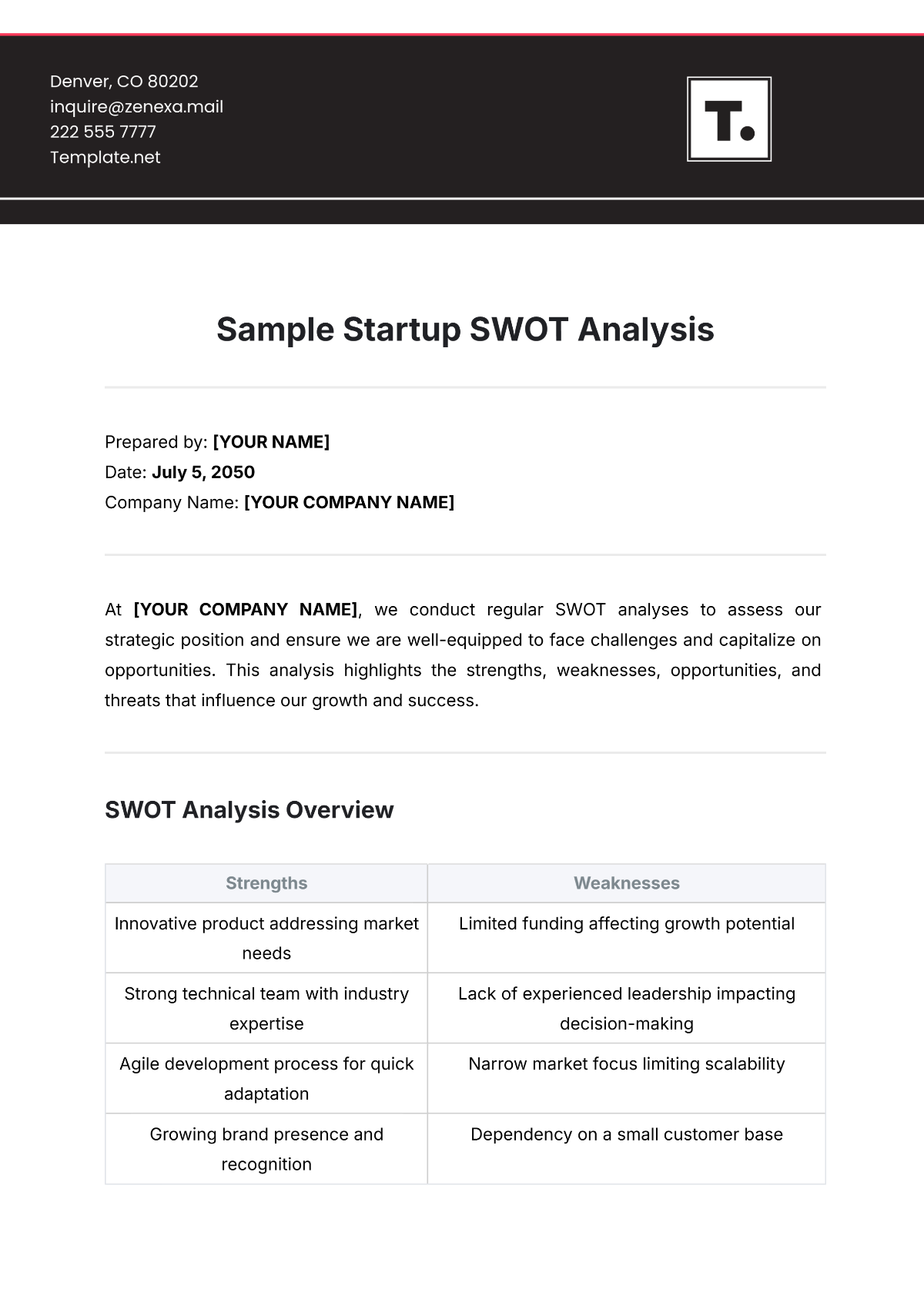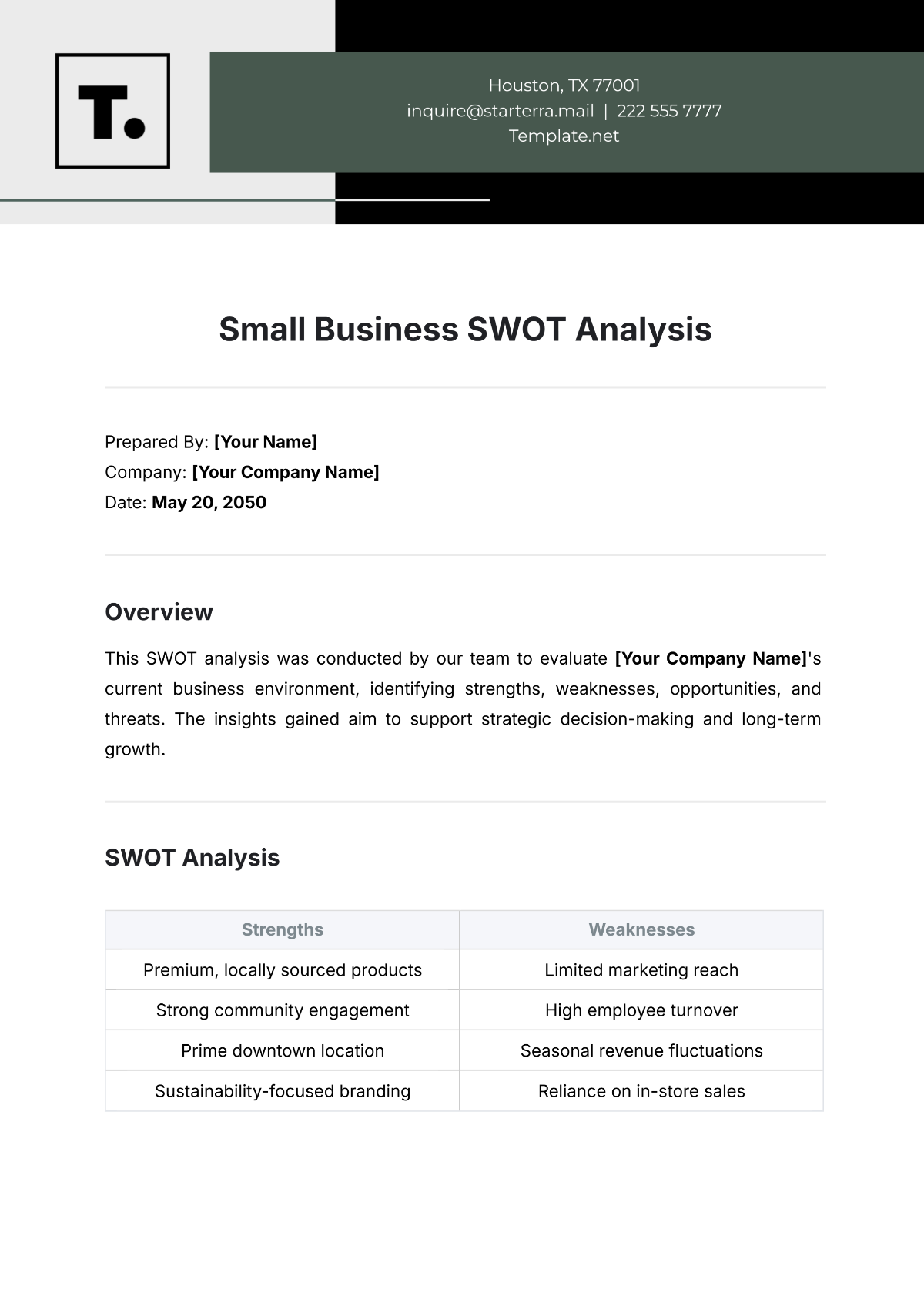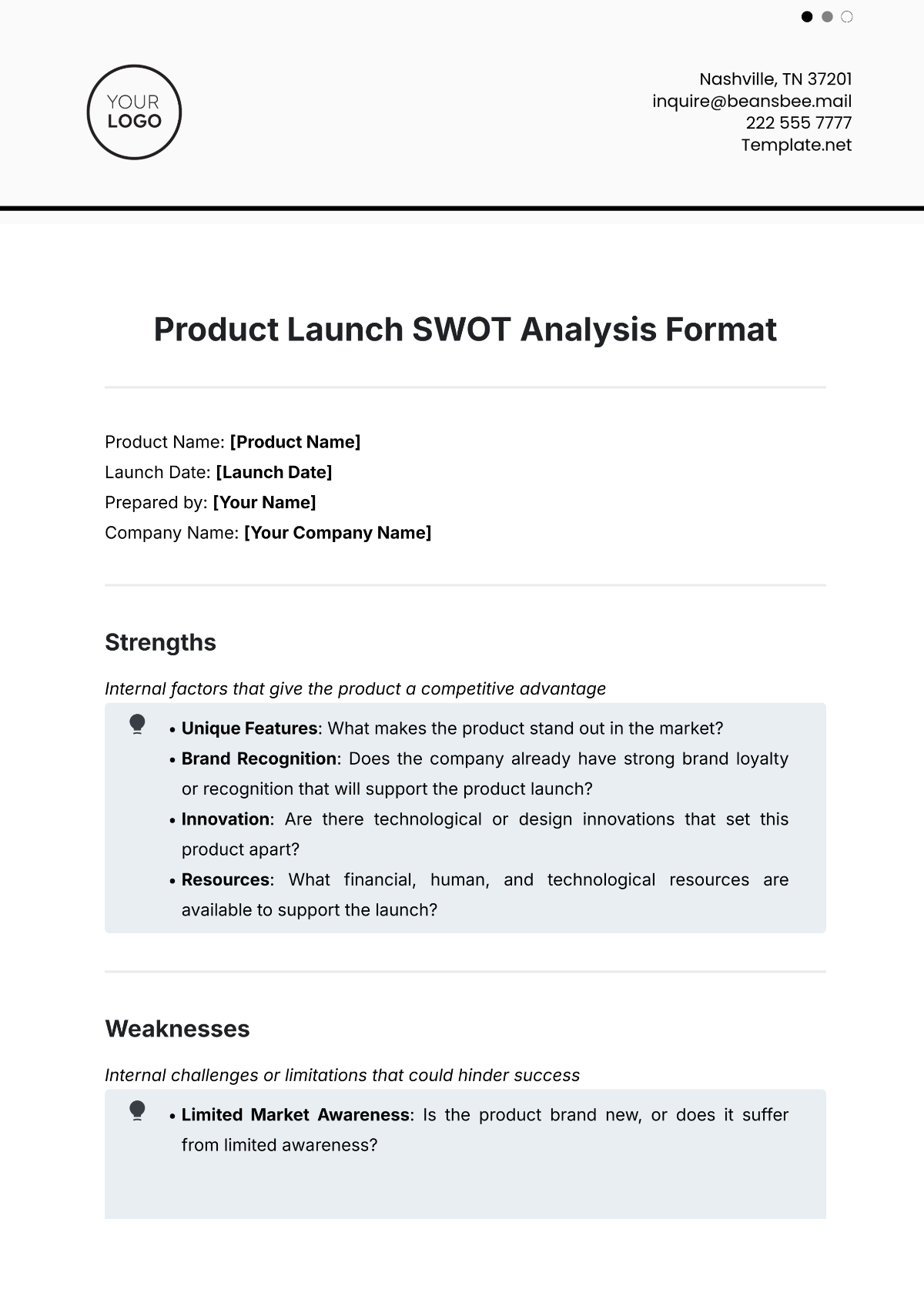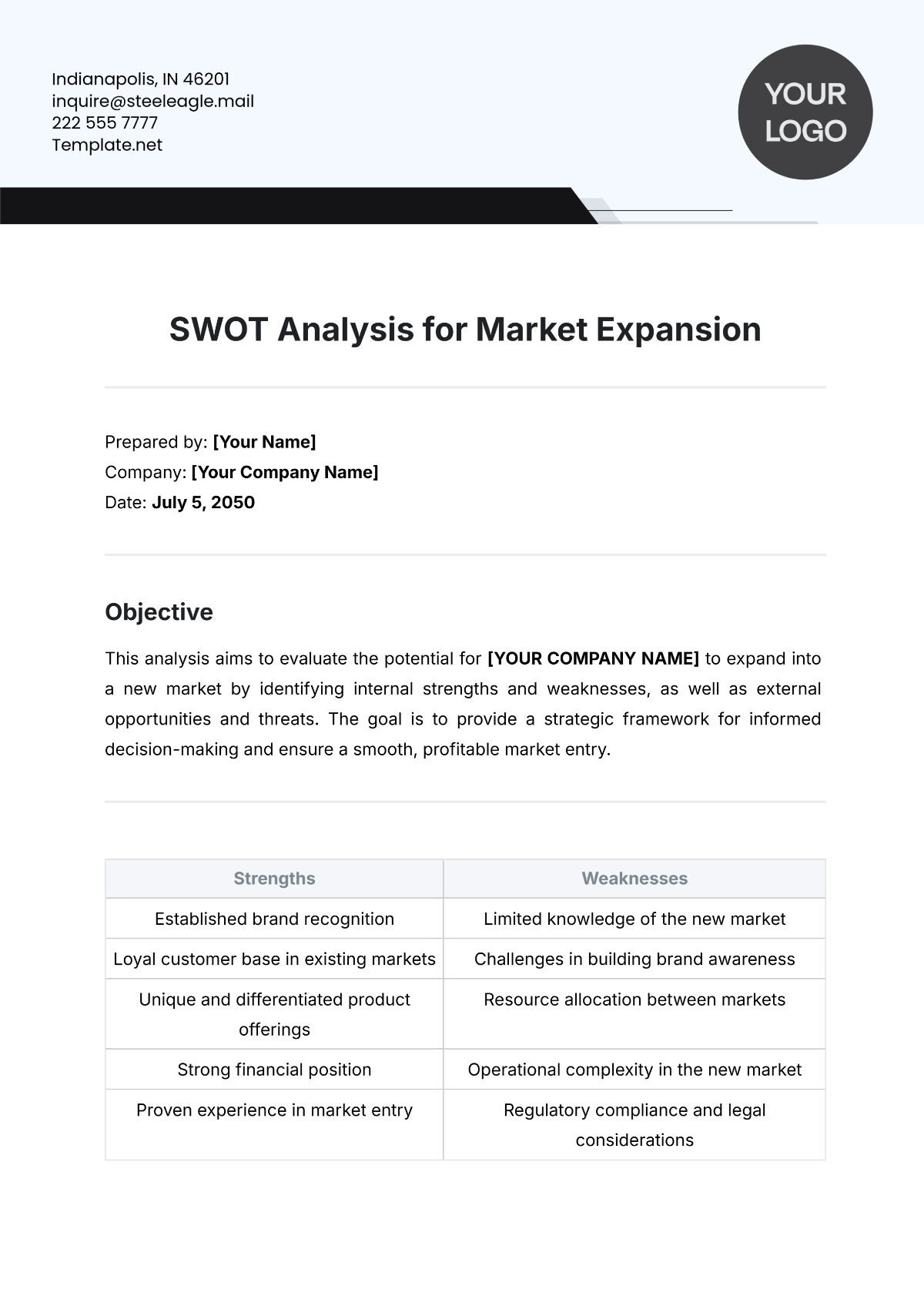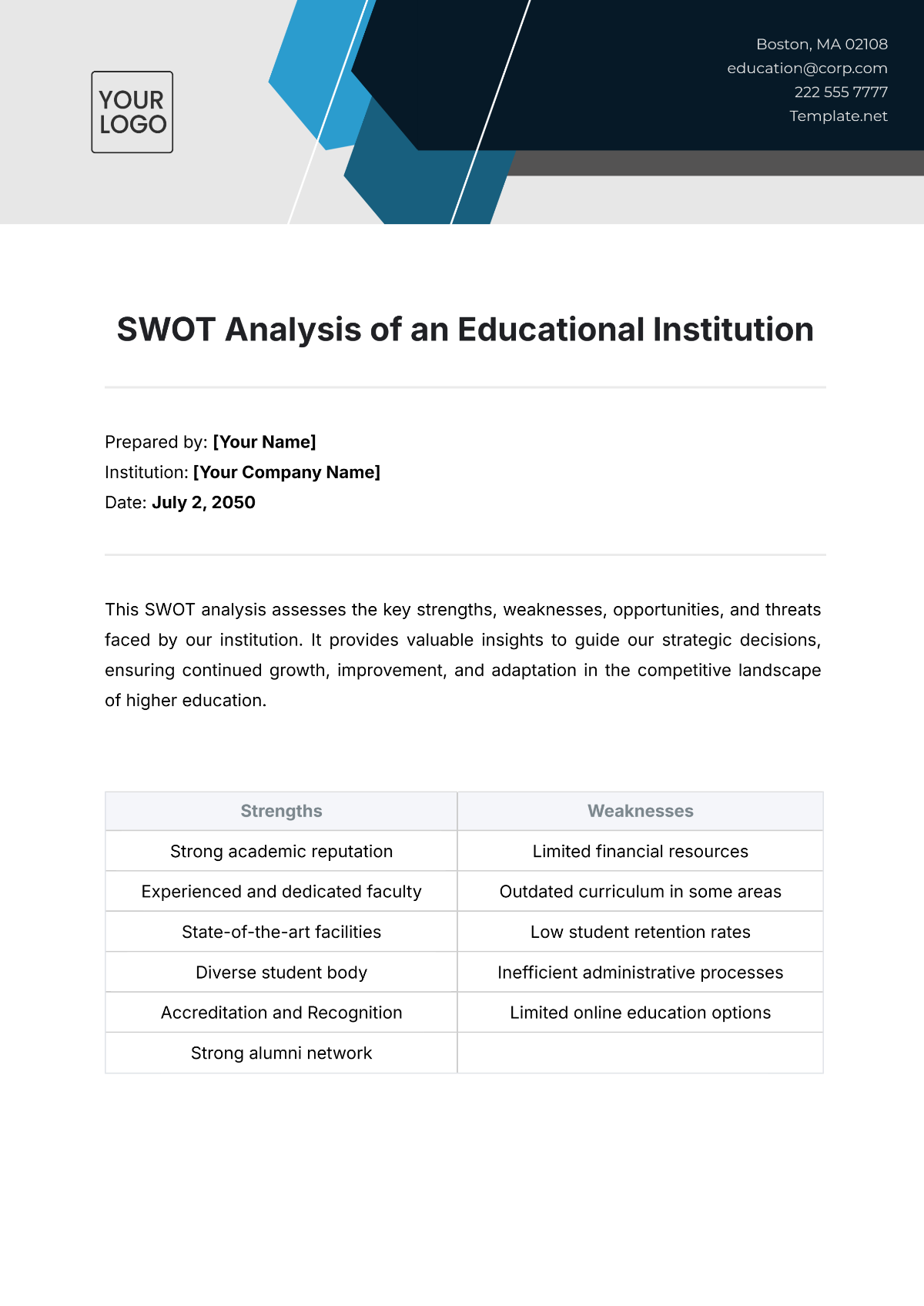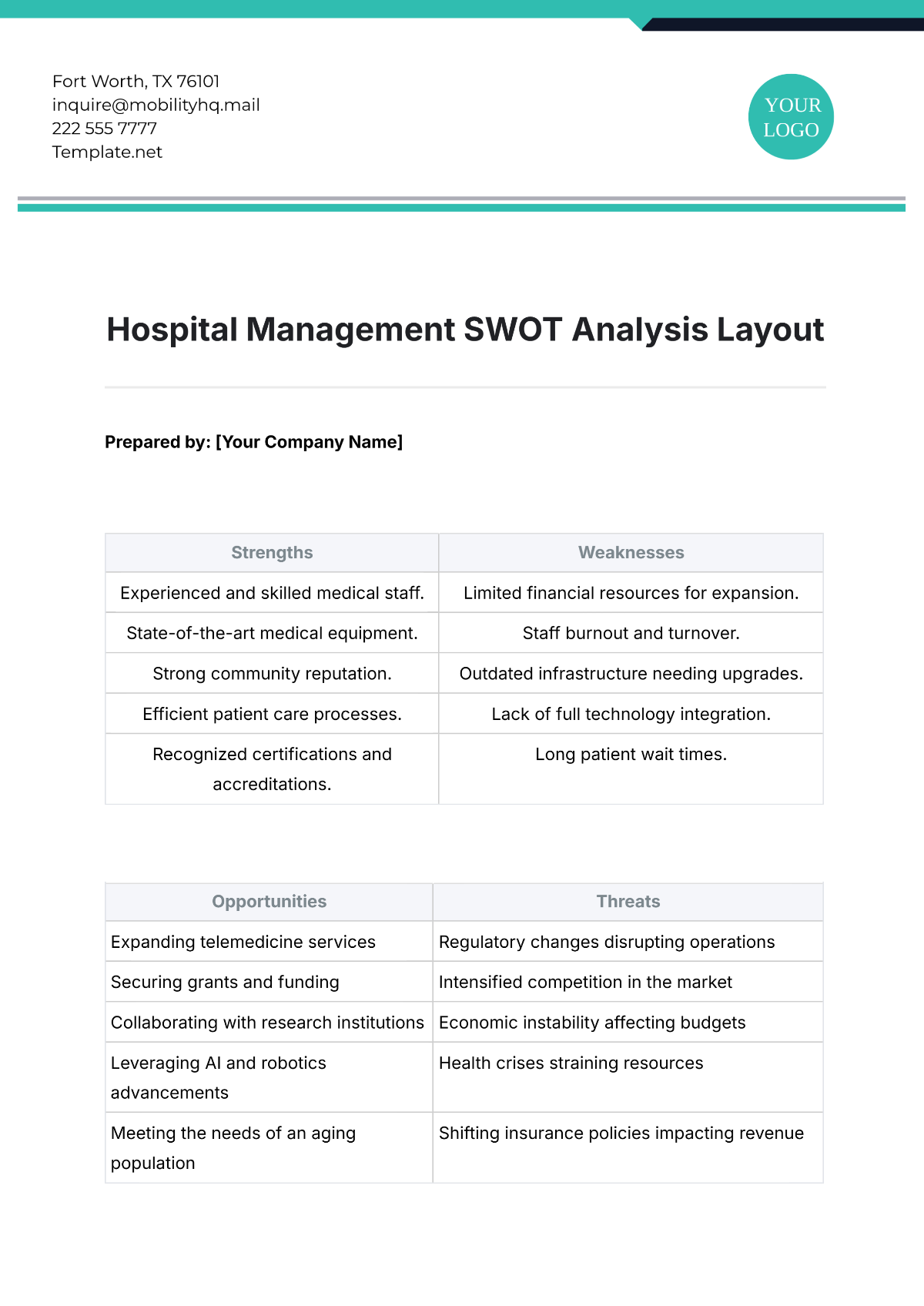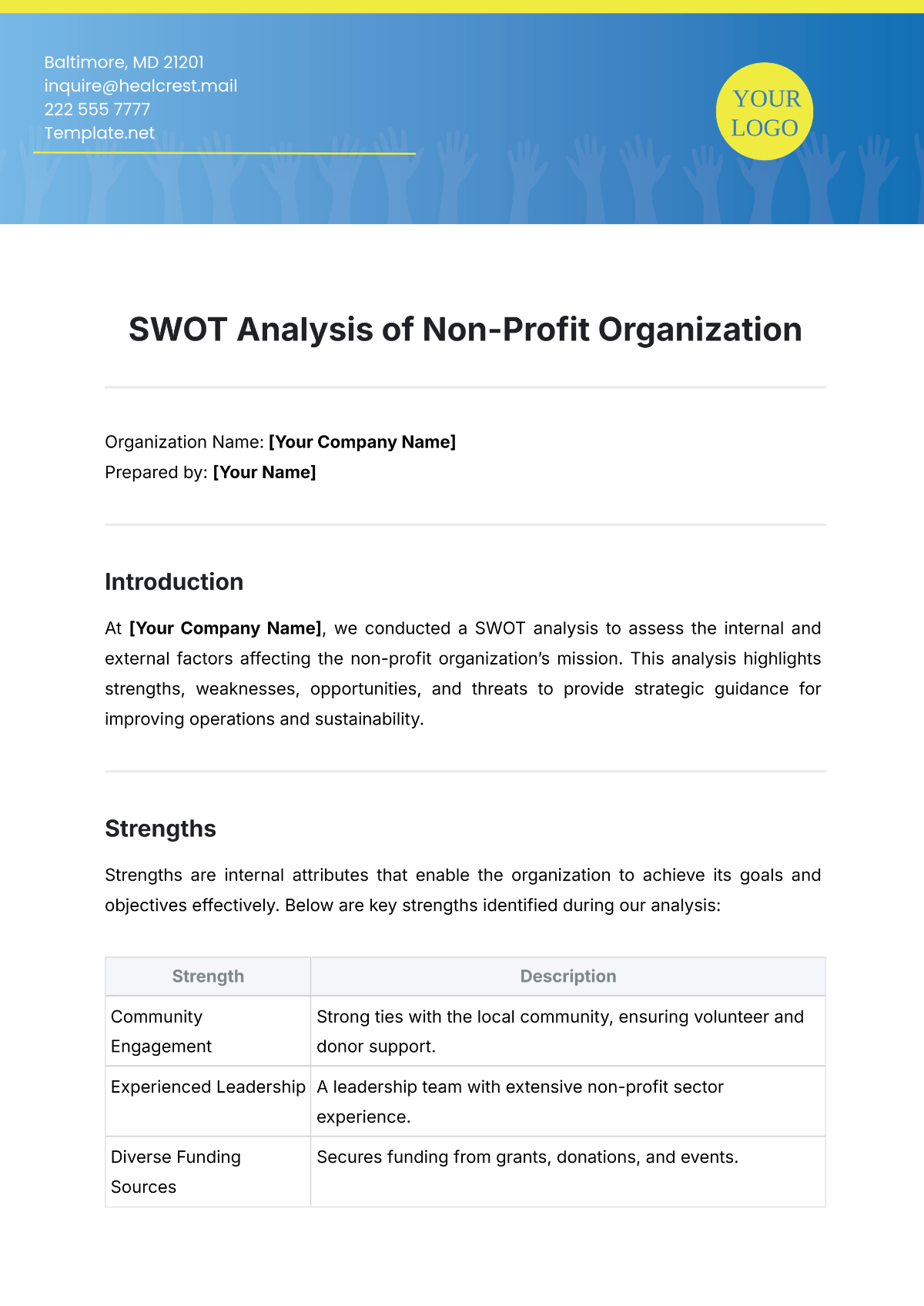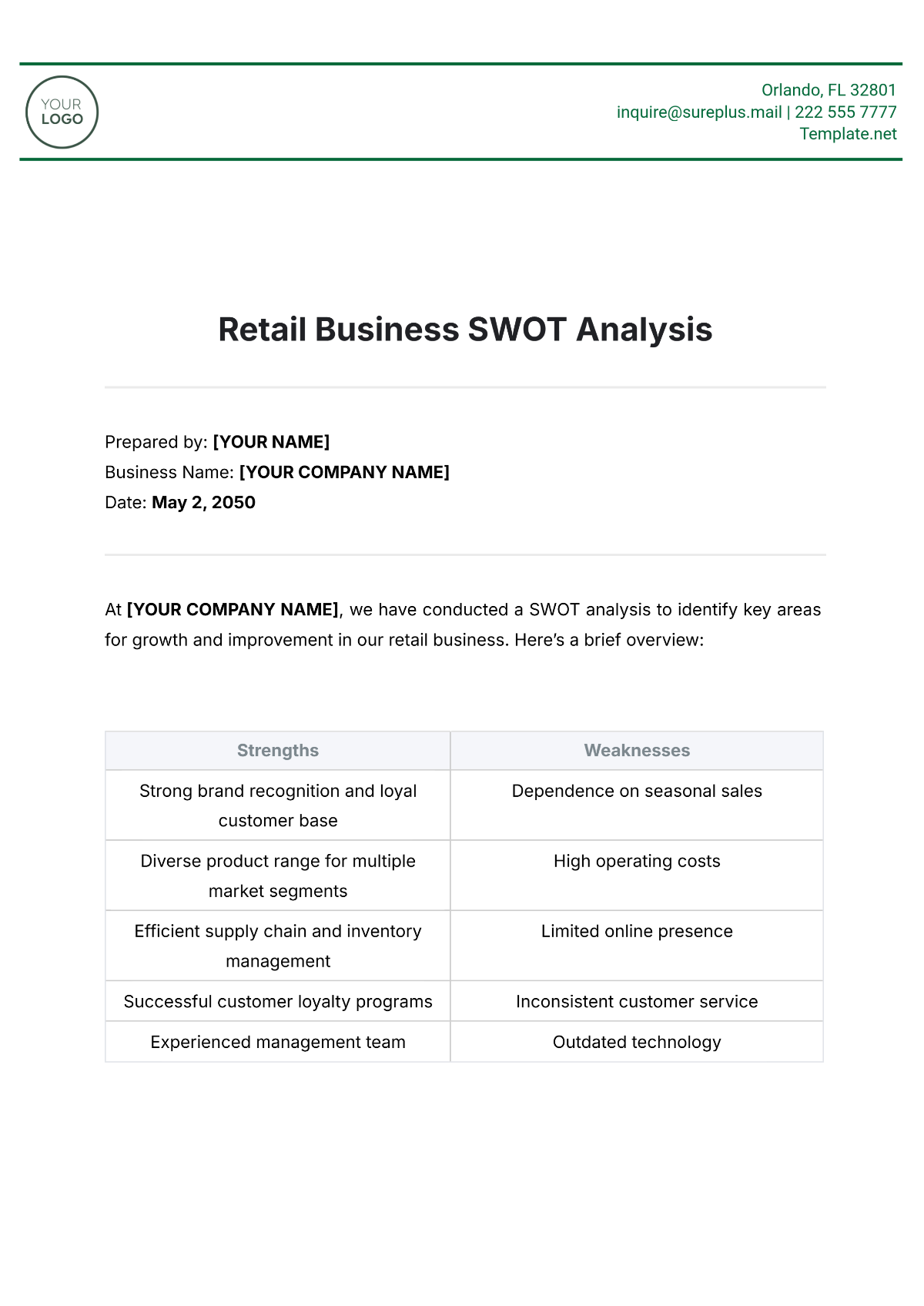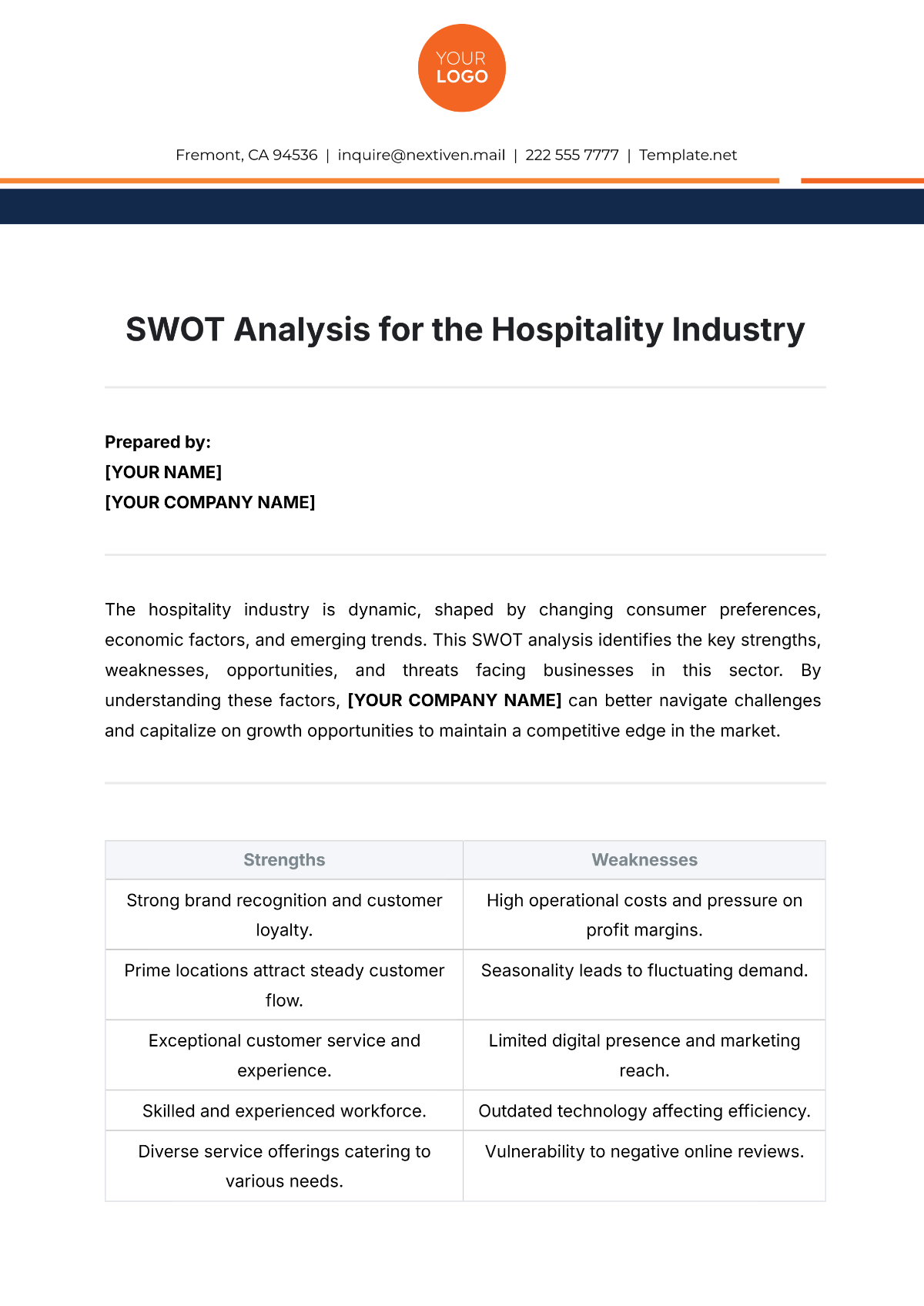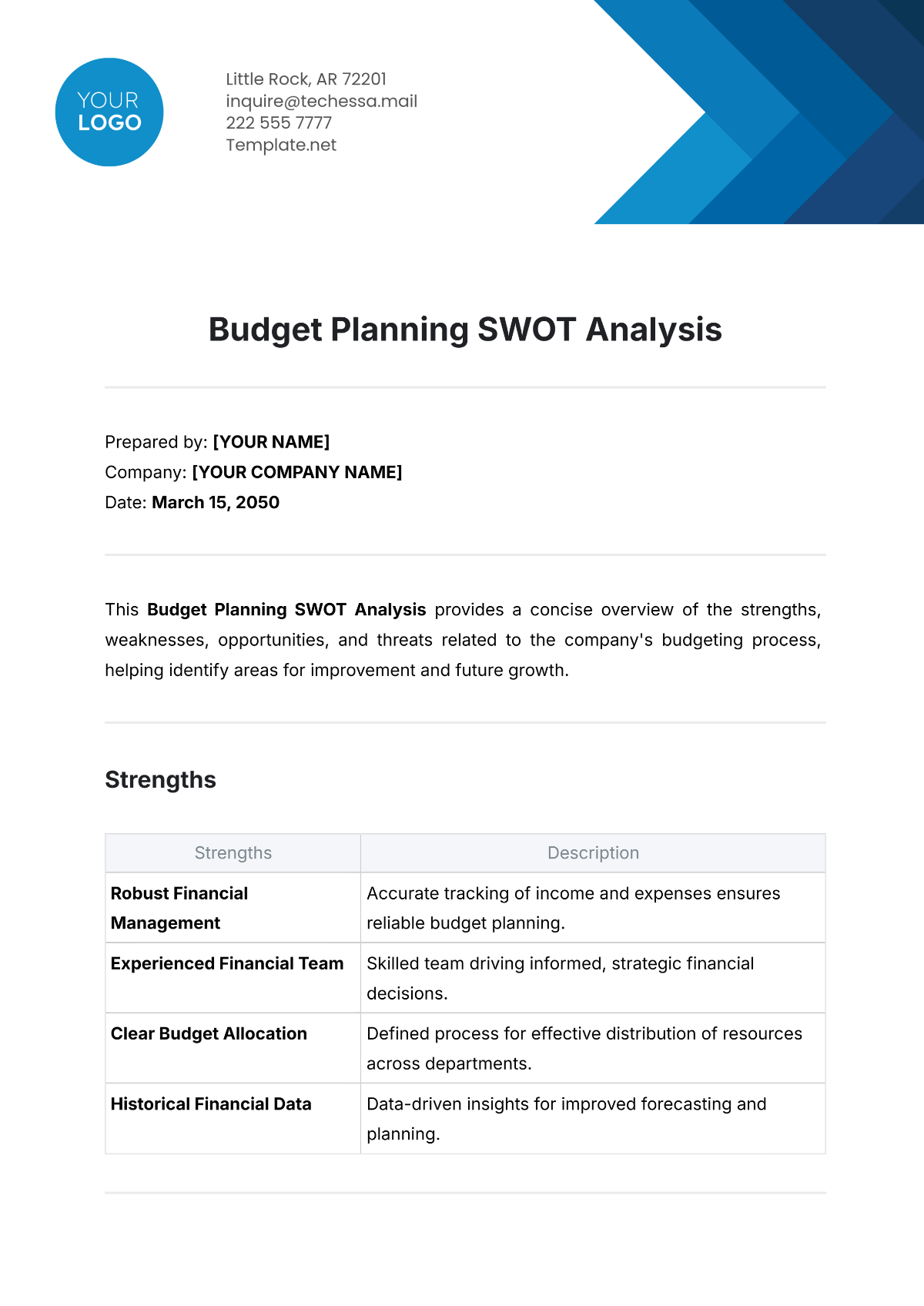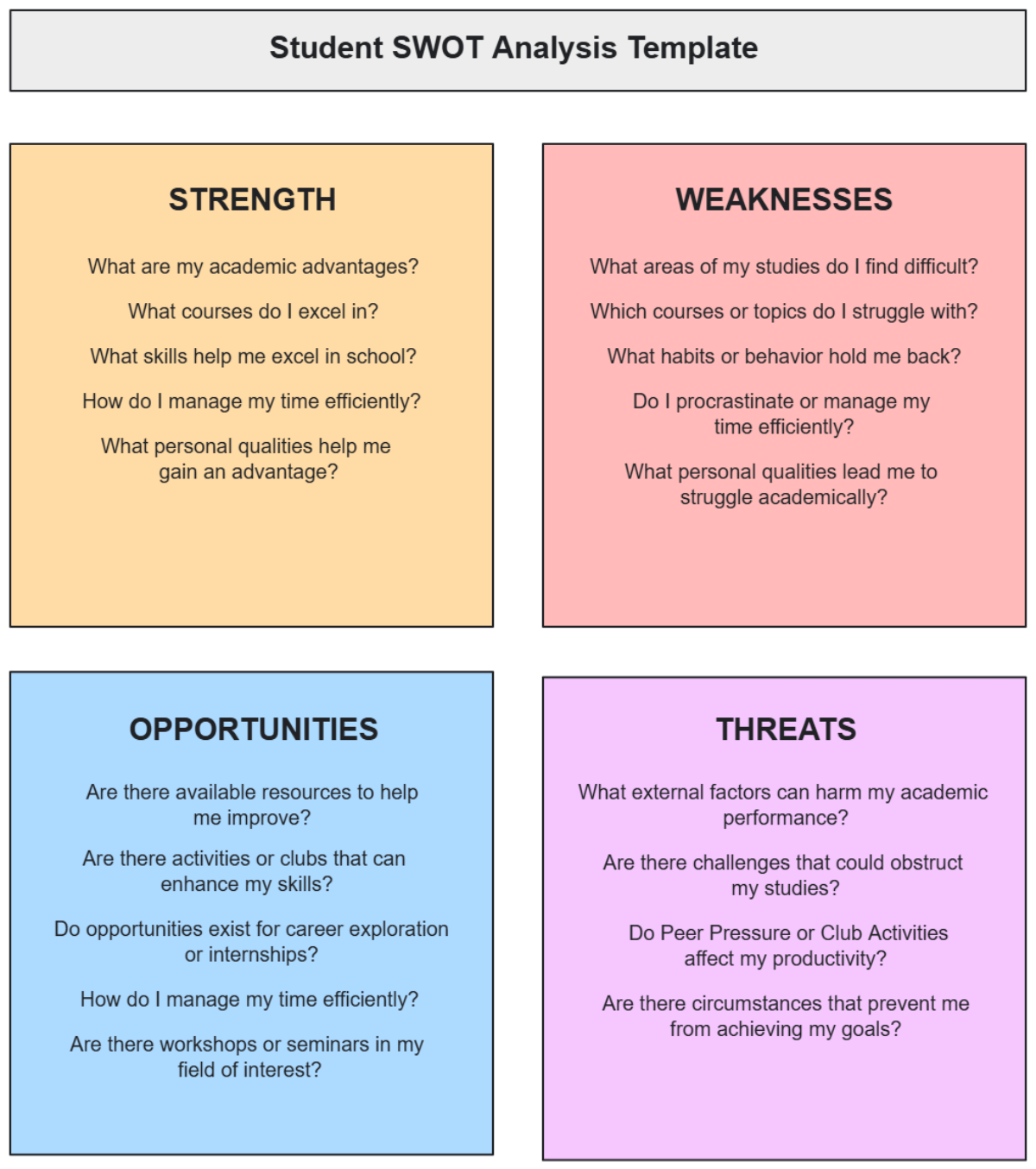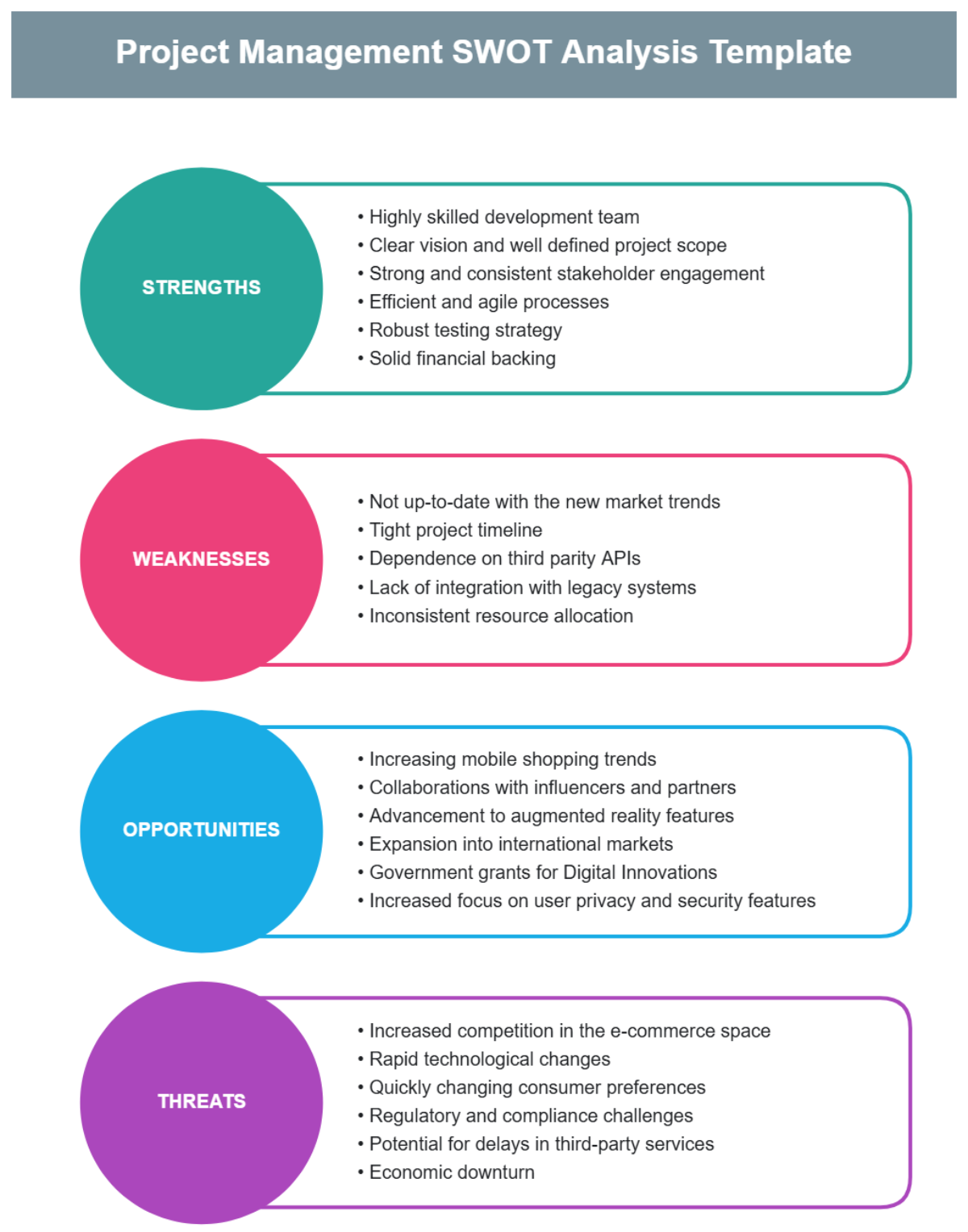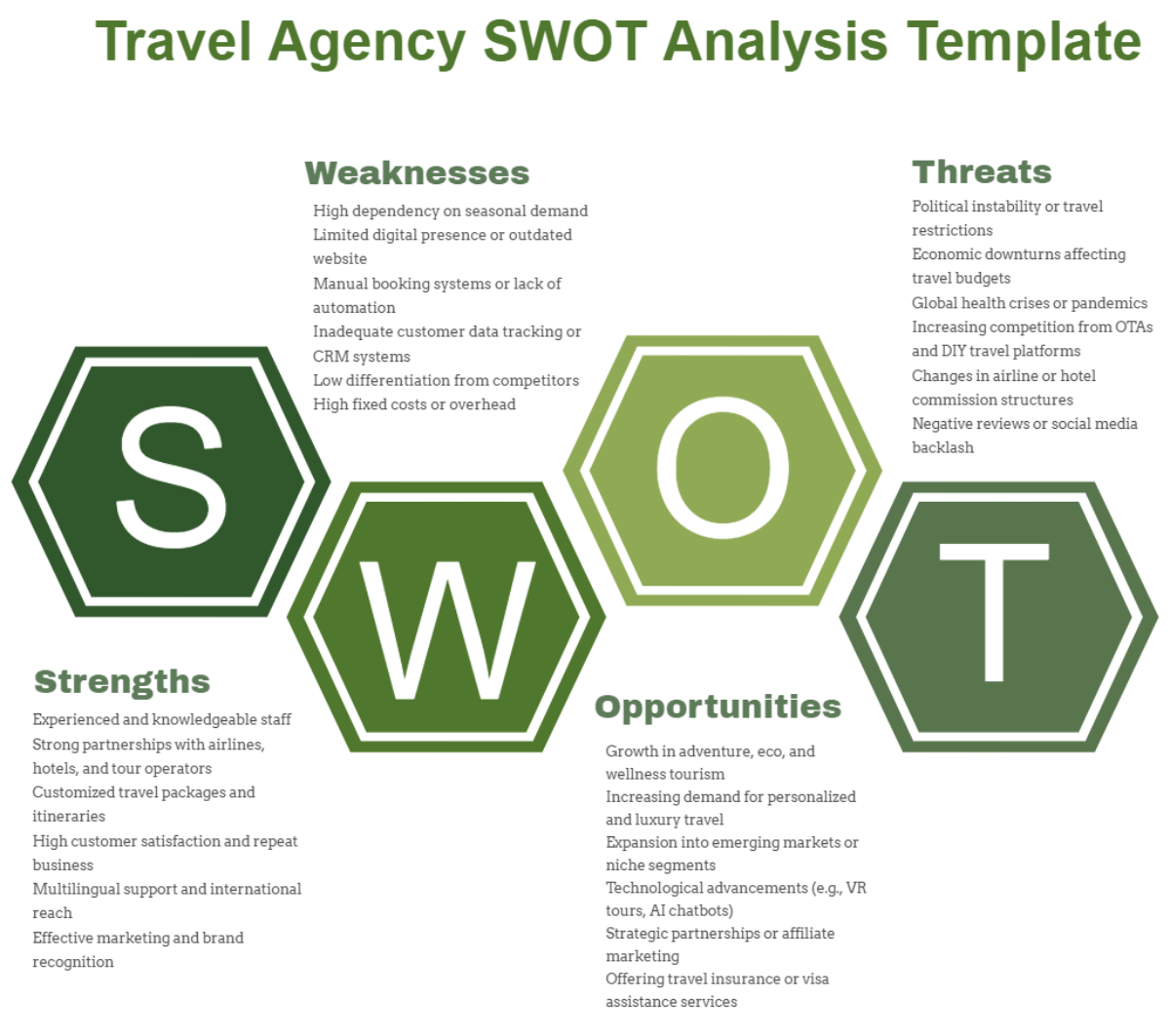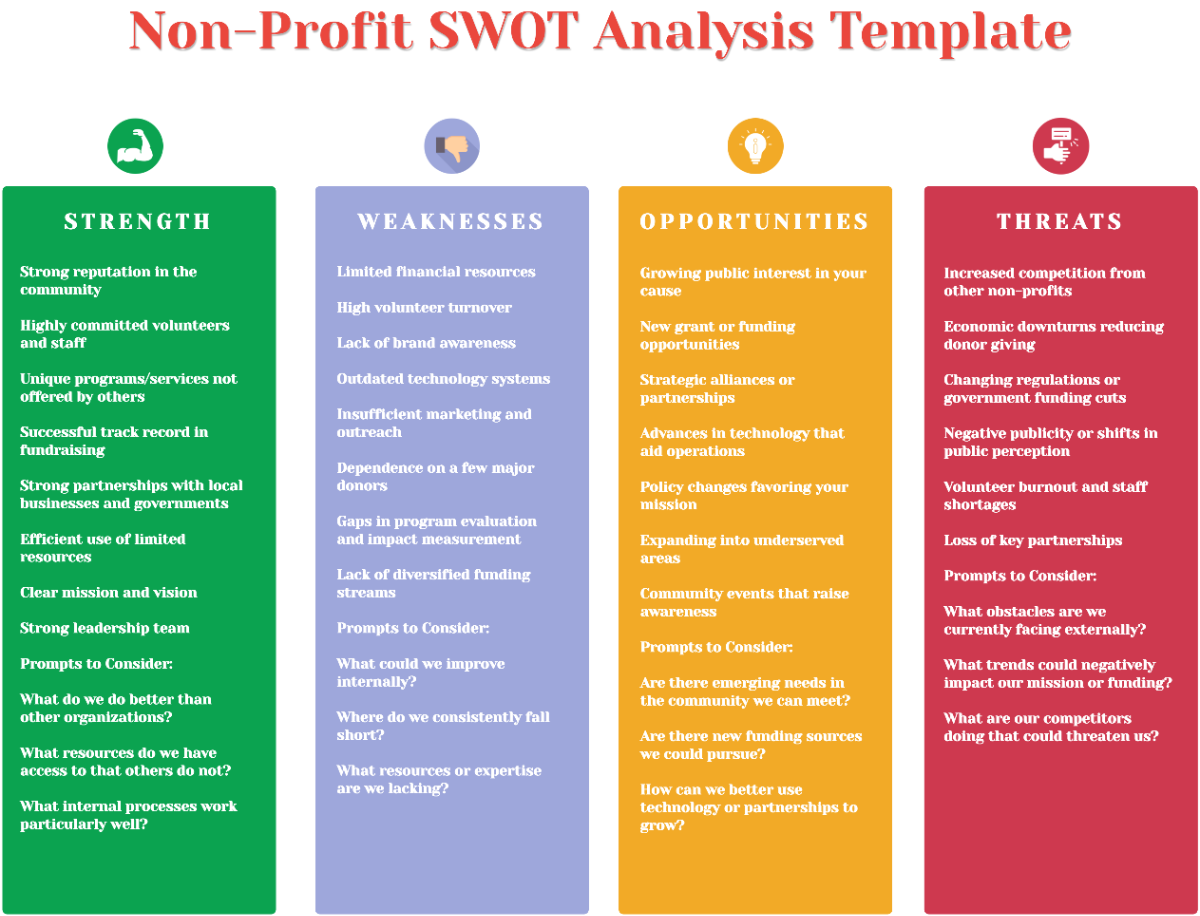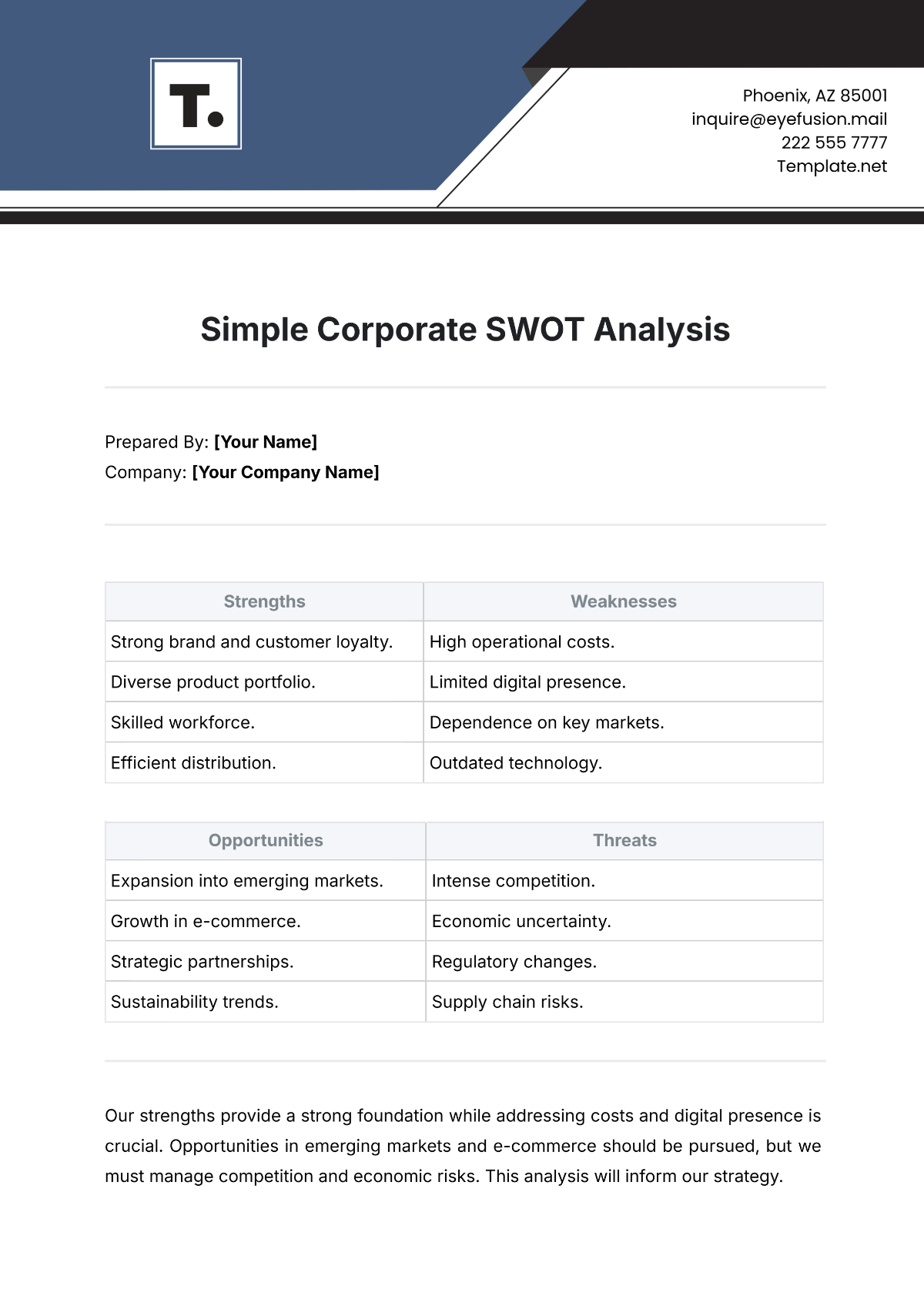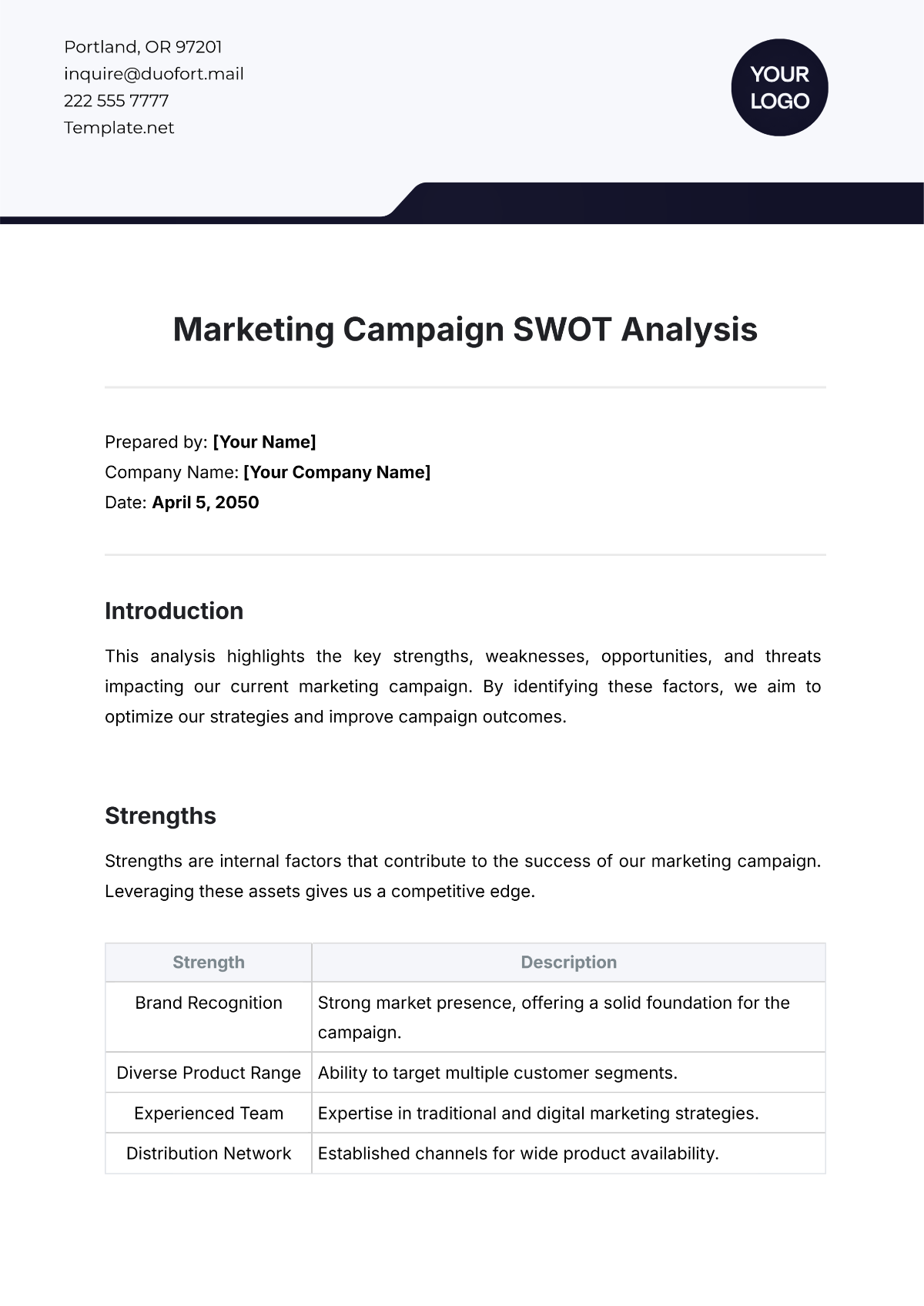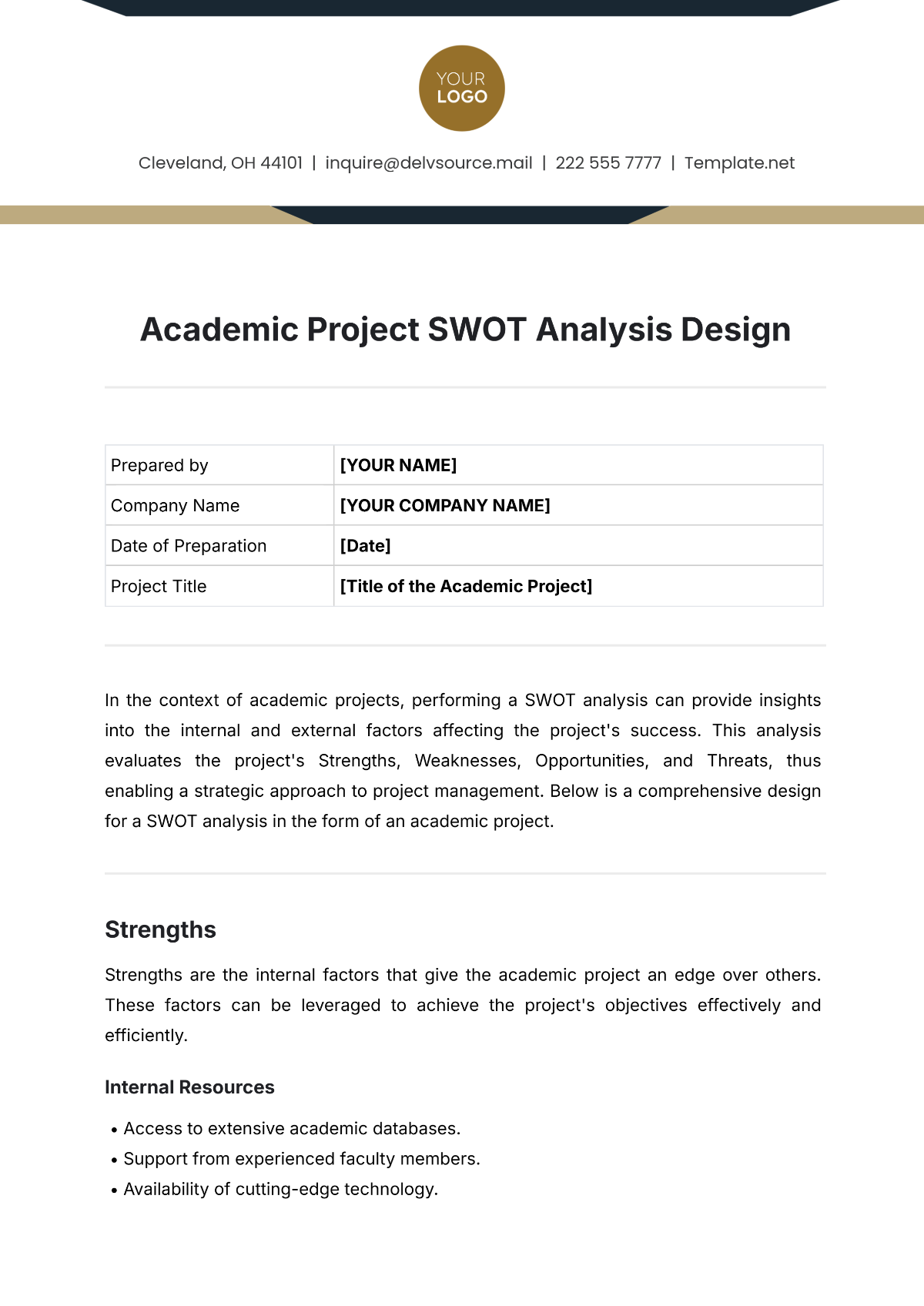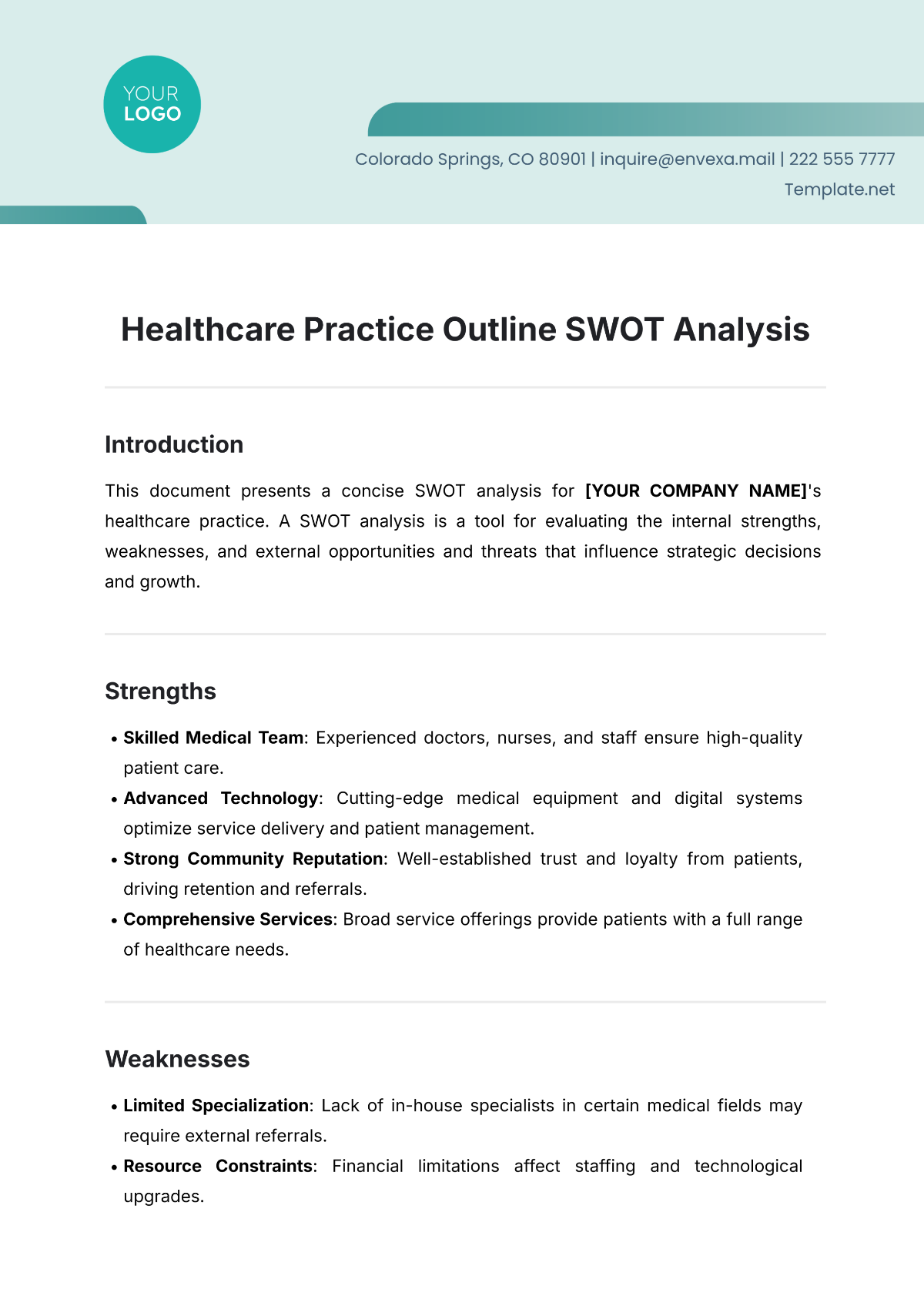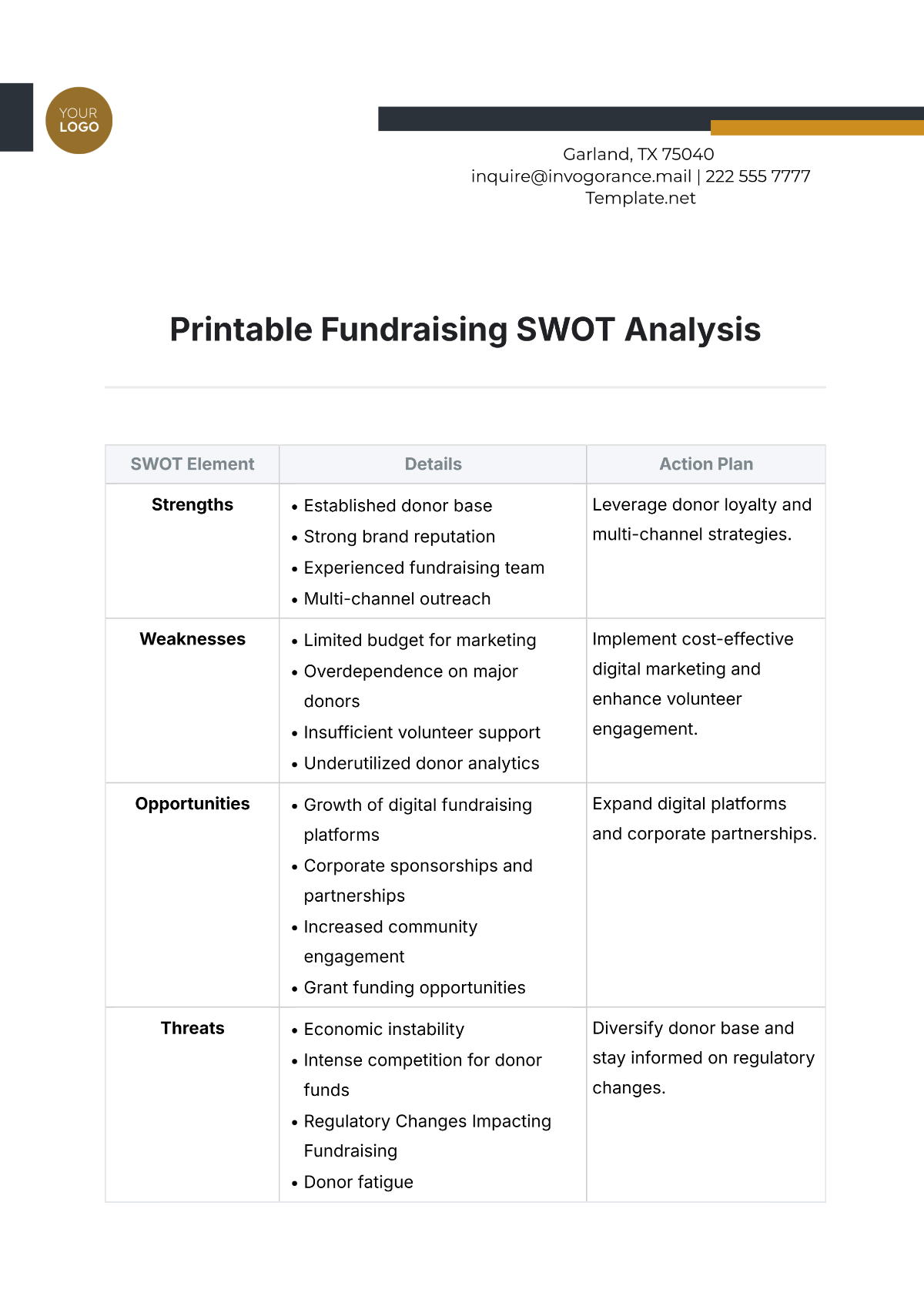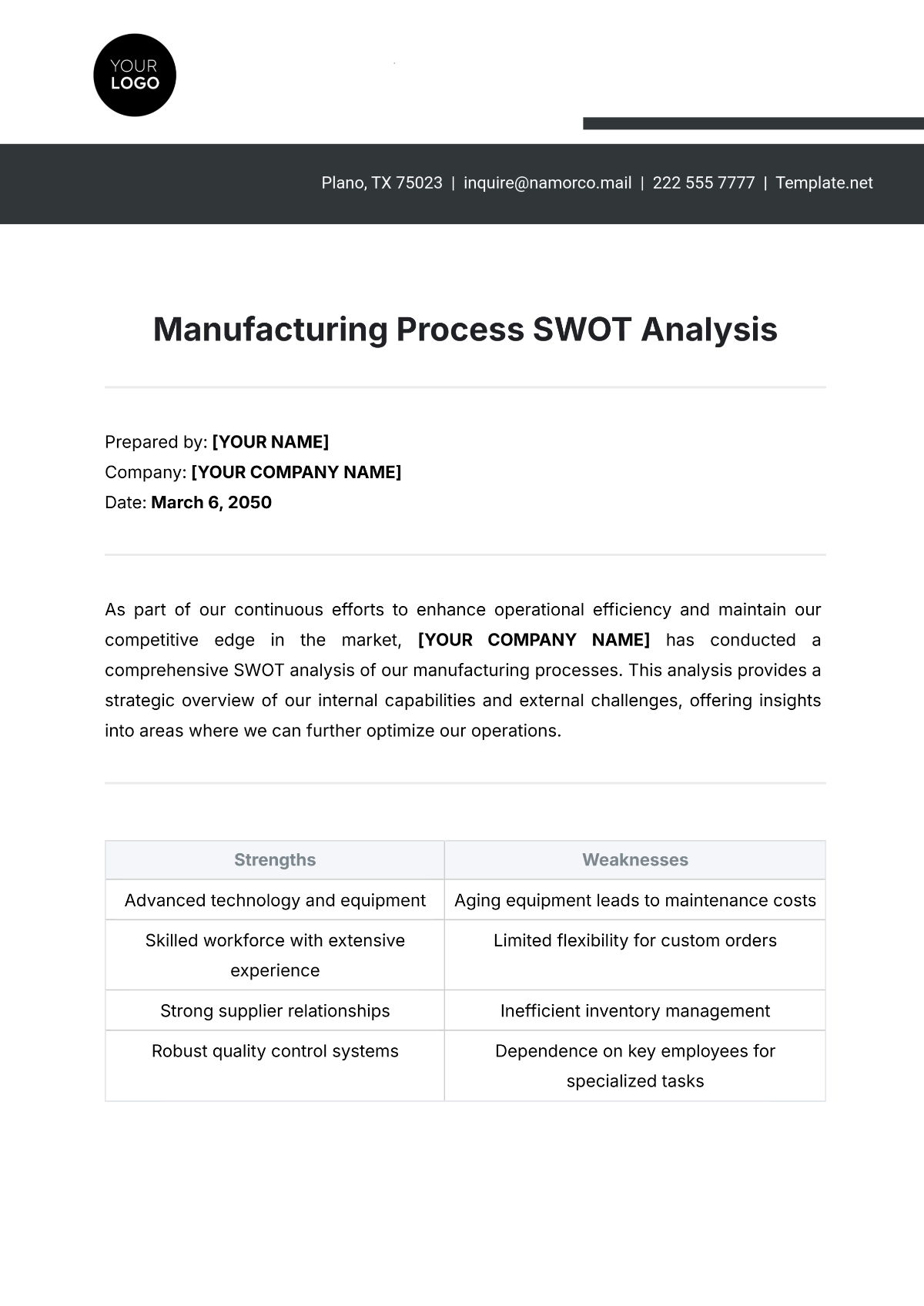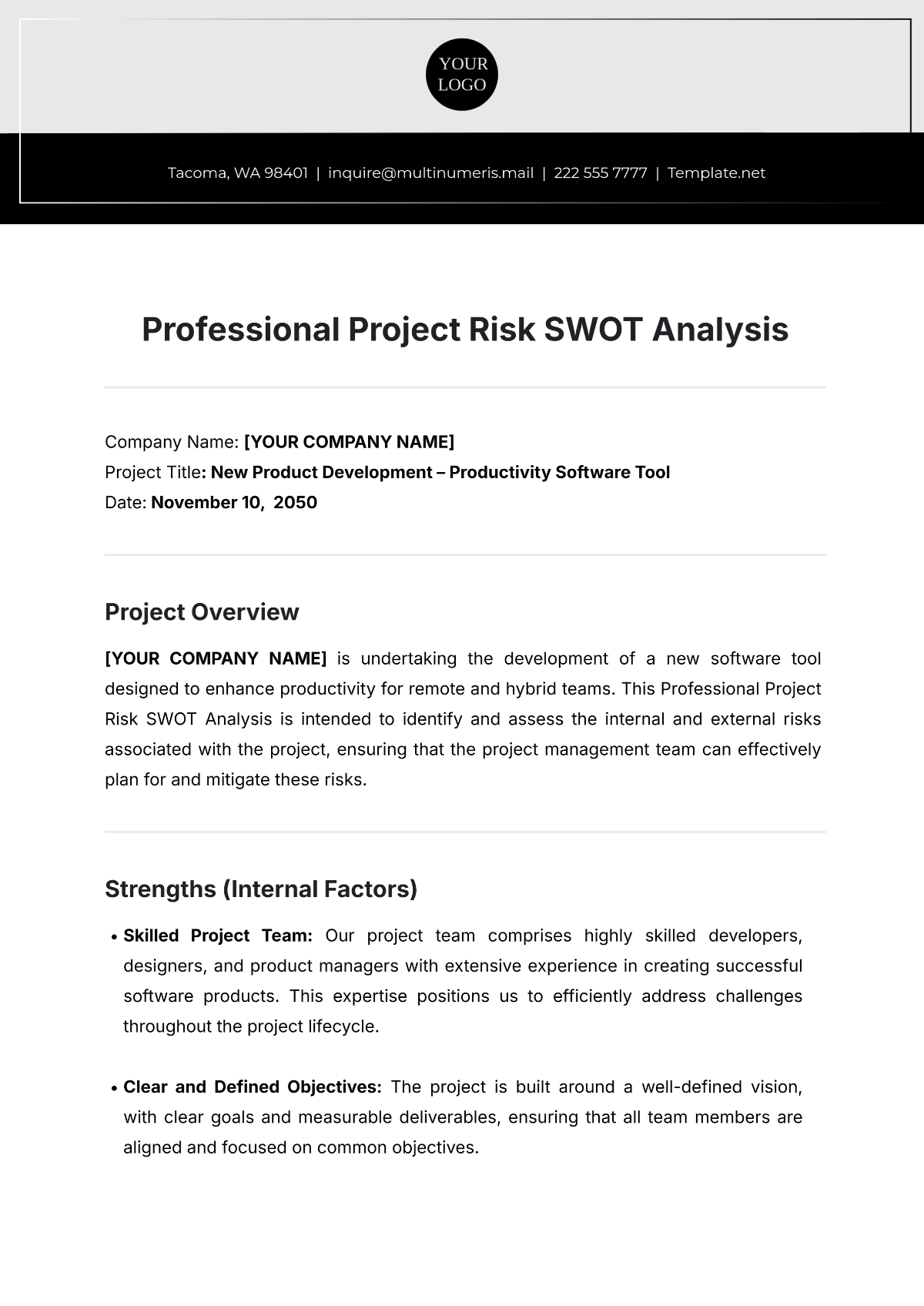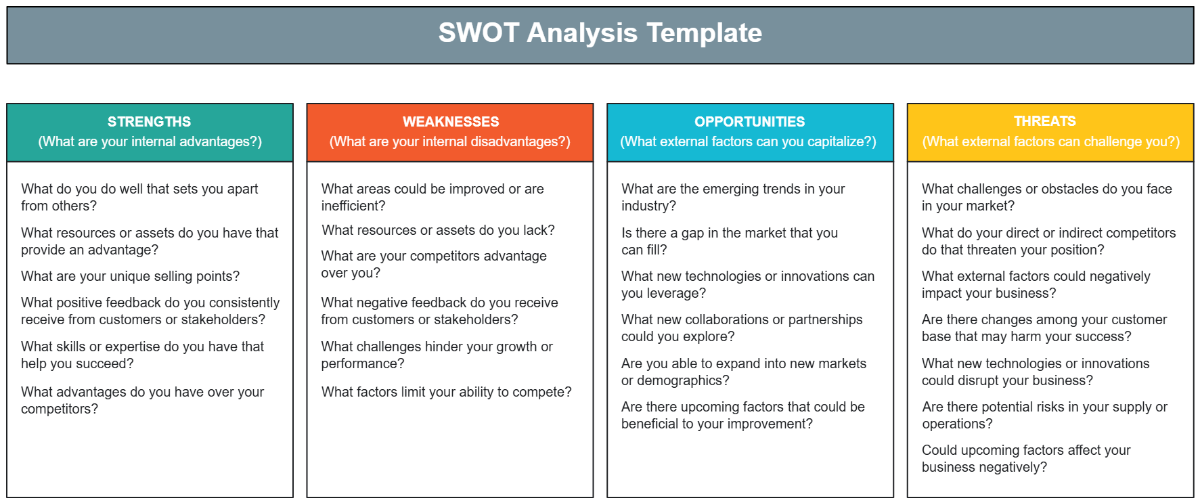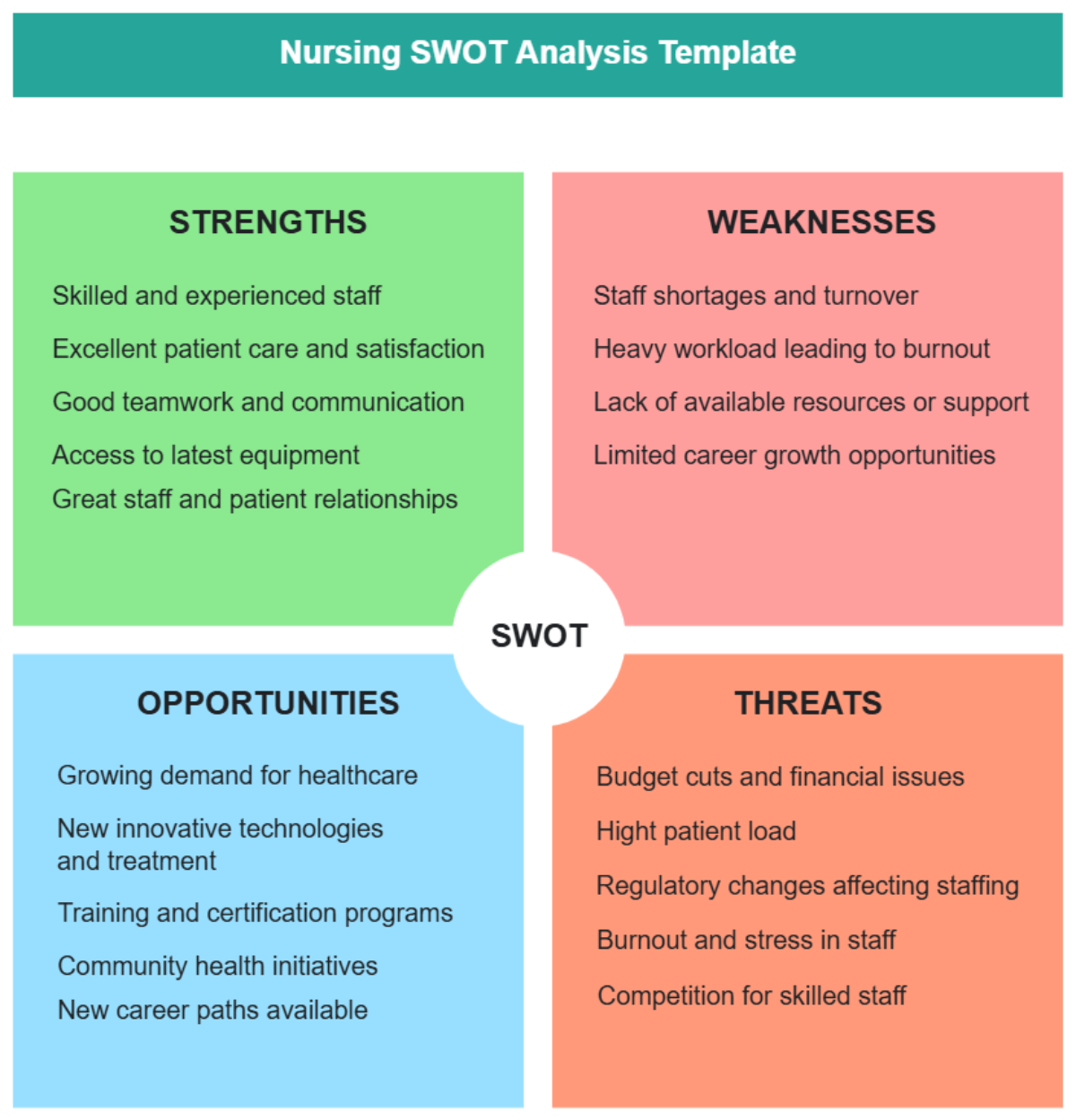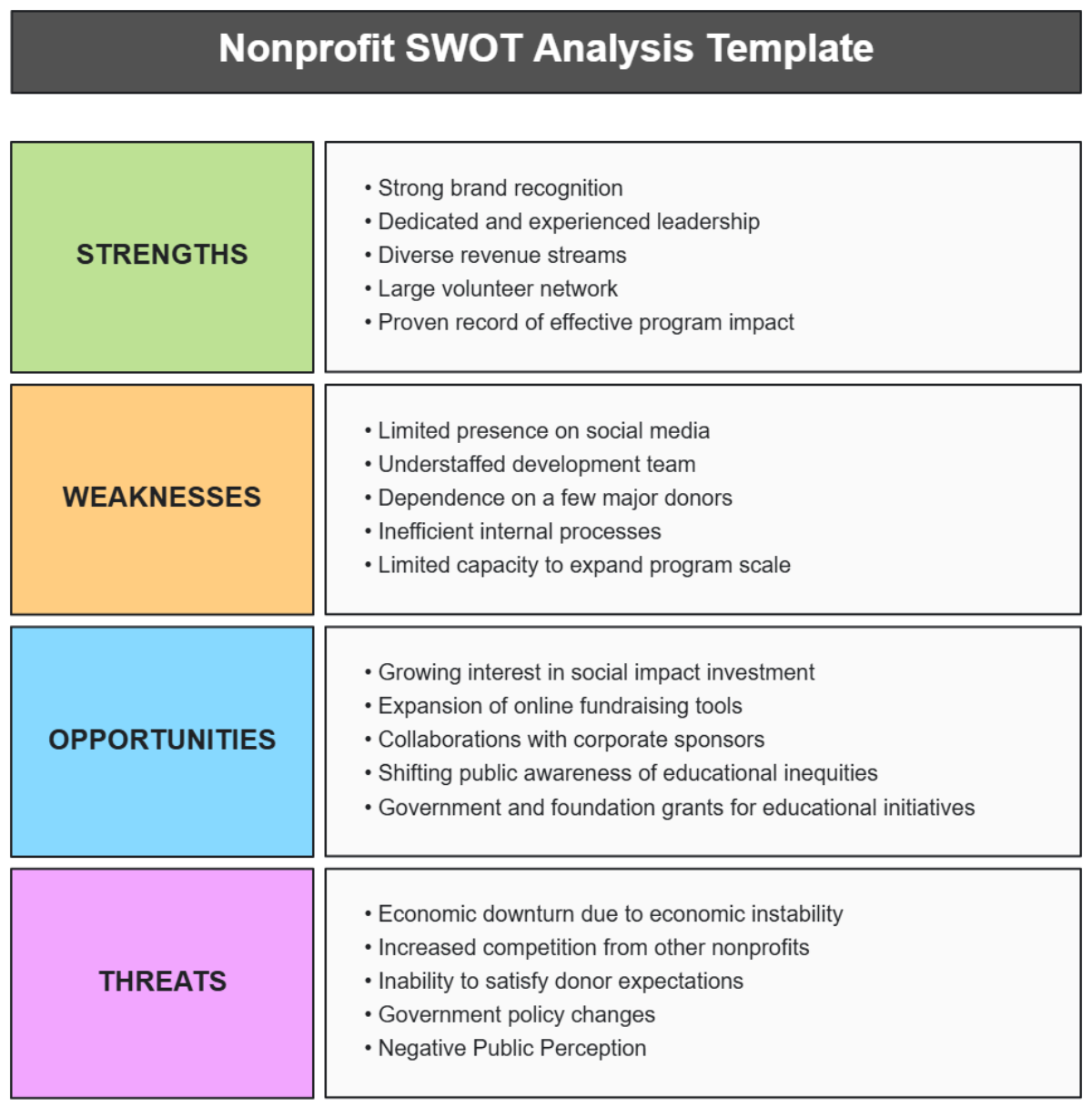Go-to-Market SWOT Analysis
I. Introduction
A. Purpose of the Analysis
The purpose of this Go-to-Market (GTM) SWOT Analysis is to evaluate the strategic position of our new health drink product, [Product Name], as we prepare for its launch in the competitive beverage market. By identifying internal strengths and weaknesses, as well as external opportunities and threats, we aim to develop a robust marketing strategy that maximizes our chances of success. This analysis will serve as a foundation for making informed decisions about product positioning, pricing, and promotional tactics.
B. Overview of the Product/Service
[Product Name] is a functional health drink designed to enhance energy levels and support overall wellness. It is formulated with a blend of natural ingredients, including vitamins, minerals, and adaptogens, to provide health benefits without artificial additives or preservatives. The product is packaged in eco-friendly materials, appealing to environmentally conscious consumers and aligning with current sustainability trends.
C. Target Market Description
Our primary target market consists of health-conscious adults aged 25-45, who are interested in wellness trends and are willing to pay a premium for high-quality, natural products. This demographic is characterized by a preference for products that support active lifestyles, and they often seek convenient options that fit their busy schedules. Secondary markets include fitness enthusiasts and individuals with dietary restrictions, such as gluten-free or vegan consumers.
II. SWOT Analysis Framework
A. Definition of SWOT Analysis
A SWOT Analysis is a strategic planning tool that identifies the internal strengths and weaknesses of an organization, alongside external opportunities and threats in the market environment. By evaluating these factors, businesses can make informed decisions that enhance their market positioning and resource allocation. This analysis is particularly useful in guiding the development of marketing strategies and addressing potential challenges before product launch.
B. Importance of SWOT in Go-to-Market Strategy
Conducting a SWOT Analysis is crucial for understanding our competitive position and aligning our resources effectively. It helps identify market gaps where our product can excel and areas where improvements are needed. Moreover, it provides a structured approach to evaluating the landscape in which we will operate, ensuring that we are well-prepared to address challenges and capitalize on opportunities.
III. Strengths
A. Internal Resources
Brand Reputation
Our company has established a strong brand reputation for quality and innovation in the health and wellness sector. This reputation is supported by positive customer testimonials and reviews, which enhance consumer trust. Leveraging this brand equity will be vital in gaining initial traction for [Product Name].
Product Quality and Features
[Product Name] is made from organic ingredients, free from artificial additives and preservatives, setting it apart from many competitors. The formulation is backed by scientific research, demonstrating its efficacy in boosting energy and promoting wellness. This focus on quality aligns with consumer demands for transparency and health benefits in their product choices.
Skilled Workforce
Our team includes experts in nutrition, product development, and marketing, ensuring a well-rounded approach to product launch. This diverse skill set allows us to create effective messaging that resonates with our target audience. Furthermore, ongoing training and development programs will keep our workforce updated on industry trends and consumer preferences.
B. Competitive Advantages
Unique Selling Proposition (USP)
Our USP lies in our commitment to using only natural, sustainably sourced ingredients that promote health and wellness. This focus on sustainability is increasingly important to consumers who prioritize environmentally friendly products. Additionally, our unique blend of ingredients provides specific health benefits that are not commonly found in competing products.
Strong Distribution Channels
We have established relationships with major retailers and health food stores, enabling effective product placement and visibility. This network allows us to reach a broad audience quickly, ensuring that [Product Name] is accessible to our target consumers. Our distribution strategy also includes e-commerce platforms to capture the growing trend of online shopping for health products.
C. Financial Stability
Funding and Investment Capacity
Our recent round of funding provides the necessary resources to support extensive marketing efforts and distribution. This financial backing enables us to invest in high-impact advertising campaigns, sampling initiatives, and promotional events. A strong financial position also allows us to explore potential future product lines and innovations.
Profit Margins
The premium pricing strategy allows for healthy profit margins, facilitating reinvestment into product development. We have conducted a cost analysis that indicates our price point is competitive while still maintaining profitability. This financial strategy positions us to withstand market fluctuations and invest in long-term growth.
IV. Weaknesses
A. Internal Limitations
Lack of Market Experience
As a new entrant in the beverage market, we lack extensive experience compared to established competitors. This inexperience may affect our ability to navigate industry challenges effectively. To address this, we are seeking partnerships with industry experts and consultants who can provide valuable insights.
Limited Product Range
Currently, [Product Name] is our only product, limiting our ability to offer a diverse portfolio to customers. This lack of variety may deter some consumers who prefer multiple options from a single brand. Developing additional flavors or product lines will be essential for attracting a wider audience and encouraging repeat purchases.
B. Resource Constraints
Insufficient Budget for Marketing
While our funding is stable, budget constraints may limit our initial marketing campaigns compared to competitors. A more modest budget may restrict our reach and frequency in advertising. We will need to prioritize high-impact marketing strategies that deliver the best return on investment to maximize our budget.
Weak Sales Force
Our sales team is relatively small, which may hinder our outreach efforts in the initial launch phase. A limited sales force could impact our ability to establish relationships with retailers and distributors. To mitigate this weakness, we plan to invest in training and potentially expand our sales team as demand grows.
C. Operational Challenges
Production Limitations
Our production capacity may initially restrict the volume of products available for launch. Ensuring a consistent supply of high-quality ingredients may also pose challenges. We must implement efficient production processes and develop contingency plans for ingredient sourcing to meet demand.
Supply Chain Issues
Dependence on specific suppliers for organic ingredients could pose risks to production consistency. Any disruptions in the supply chain may delay product availability and impact sales. Establishing relationships with multiple suppliers and maintaining a buffer stock of key ingredients will be crucial for mitigating this risk.
V. Opportunities
A. Market Trends
Emerging Technologies
Advancements in food technology can help improve product formulation and shelf life. For example, innovations in natural preservation methods could enhance product stability without compromising quality. Staying abreast of technological advancements will allow us to continually refine our offerings and maintain a competitive edge.
Changing Consumer Preferences
A growing trend toward healthy living and natural products presents a favorable market environment. Consumers increasingly seek products that contribute to their well-being and align with their lifestyles. By aligning our marketing strategies with these preferences, we can effectively reach our target audience.
B. Competitive Landscape
Market Gaps and Unmet Needs
There is an increasing demand for functional beverages that offer specific health benefits, creating opportunities for our product. Market research indicates a gap in the market for energy-boosting drinks that are also natural and health-oriented. Positioning [Product Name] to fill this gap can drive consumer interest and sales.
Potential Partnerships
Collaborating with health influencers and nutritionists can enhance brand credibility and reach. These partnerships can help us tap into established audiences who trust their recommendations. We plan to develop influencer marketing campaigns that leverage social media platforms for maximum visibility.
C. Regulatory Environment
Favorable Policies
Government initiatives supporting health and wellness products may provide additional marketing opportunities. These policies can create a more favorable environment for launching new health-focused products. Staying informed about legislative changes will help us align our strategies accordingly.
Government Incentives
Potential grants for sustainable practices could help reduce operational costs. By applying for relevant programs, we can obtain funding to support eco-friendly initiatives that align with our brand values. This not only reduces costs but also enhances our brand's appeal to environmentally conscious consumers.
VI. Threats
A. Competitive Pressures
Existing Competitors
Established brands in the health drink market, such as [Competitor A] and [Competitor B], pose significant competition, with strong loyalty from consumers. These brands have extensive marketing budgets and well-established distribution networks, making it challenging for new entrants to gain market share. To counter this, we need to clearly differentiate "[Product Name] through targeted messaging and unique value propositions.
New Entrants
The low barrier to entry in the beverage industry may lead to an influx of new competitors seeking to capitalize on the growing health trends. With the increasing popularity of functional beverages, many startups are emerging, increasing competition for shelf space and consumer attention. Staying agile and responsive to market changes will be crucial in maintaining our competitive edge.
B. Economic Factors
Economic Downturns
Economic challenges, such as recession or inflation, could affect consumers' purchasing power, impacting premium product sales. In tighter economic conditions, consumers may prioritize essentials over discretionary spending, leading to a decline in sales of higher-priced items. To mitigate this threat, we may consider introducing promotional pricing or smaller package sizes to appeal to cost-conscious consumers.
Currency Fluctuations
Fluctuations in currency rates may affect ingredient sourcing costs, particularly for imported materials. As our product relies on organic ingredients sourced both domestically and internationally, significant currency volatility could impact our production costs and pricing strategy. Developing a flexible pricing strategy that can accommodate such fluctuations will be essential for maintaining profitability.
C. Market Dynamics
Changing Regulations
New regulations on food and beverage labeling could necessitate changes in our packaging and marketing strategies. Compliance with evolving health guidelines may require additional investments in quality control and product reformulation. Staying proactive in understanding and adapting to regulatory changes will ensure we remain compliant and avoid potential fines or recalls.
Shifts in Consumer Behavior
Rapid changes in consumer preferences may require quick adaptations to our product offerings. For instance, trends toward plant-based diets or sugar-free alternatives could influence our formulation decisions. Conducting regular market research and consumer feedback surveys will be essential for identifying shifts in preferences and adjusting our product line accordingly.
VII. Conclusion
A. Summary of Key Findings
The GTM SWOT Analysis reveals that while [Product Name] has significant strengths, such as a strong brand reputation and quality product offerings, it must address internal weaknesses and external threats to ensure a successful launch. Key strengths include our commitment to natural ingredients and strong distribution channels, while weaknesses involve limited market experience and a small sales team. Identifying opportunities for growth, particularly in market trends and partnerships, will be crucial for navigating the competitive landscape.
B. Strategic Recommendations
Leveraging Strengths and Opportunities
We should focus on marketing our product's unique qualities and explore partnerships with health influencers to maximize visibility. Investing in targeted advertising campaigns that highlight our commitment to sustainability and health benefits can effectively capture consumer interest. Additionally, expanding our online presence and e-commerce capabilities will help reach a broader audience and enhance sales potential.
Addressing Weaknesses and Threats
To overcome our lack of market experience, we will seek mentorship and guidance from industry experts while implementing a robust training program for our sales team. We should also consider diversifying our product range to reduce reliance on a single offering and better meet consumer demands. Developing a responsive pricing strategy will allow us to adapt to economic changes and remain competitive in pricing.
C. Next Steps in the Go-to-Market Strategy
The next steps include finalizing marketing campaigns, securing distribution agreements, and conducting further market research to refine our approach. We will initiate pilot launches in select markets to gather consumer feedback and make necessary adjustments before a full-scale rollout. Establishing clear metrics for success will be essential to monitor progress and optimize our Go-to-Market strategy continuously.
